

The Variegated Beds of the Welton Chalk Formation
of North Lincolnshire
Paul Hildreth
Abstract
Of all of the several hundred metres of the Chalk still exposed in Yorkshire and Lincolnshire, there is arguably none more interesting, and certainly none more conspicuous, than the thin sequence of darker, clay- and silt-rich beds that mark the base of the Welton Chalk Formation. A variety of names has been used by the many authors who have described these beds, perhaps the most familiar being the Black Band, and this has given rise to a certain amount of confusion. The full sequence is still exposed at seven localities in North Lincolnshire from which a stratigraphical pattem can be recognised. The lithologies of individual units are described in detail and correlations made between sections. Simple statistical methods have been employed in an attempt to analyse the stratigraphical pattem.
Introduction
Many previous workers have referred to the beds at the base of the Welton Chalk Formation as the 'Black Band' (Neale 1974; Wood and Smith 1978; Wood 1980; Mitchell 1995), the Black Band Member (Horne 1995) or, probably erroneously, the 'Plenus Marl' (Rowe 1904; Wilson 1948; Whitham 1991). Jefferies (1963) stated that the faunal assemblage of the conglomeratic bed at the base of the sequence characterises high levels within the Plenus Marls and that the 'Black Band' is therefore probably younger. Wood (in Gaunt, Fletcher and Wood 1992) has presented a convincing argument for a post-Plenus Mari age for most of the sequence and shown that only the upper part of the Plenus Marls is represented in northern England. Wood (in Kent 1980) further states that microfossil evidence supports this view. The term Variegated Beds was introduced by Wood and Mortimore (1995) to emphasise the complexity and lithological variety displayed within the sequence. Descriptions and detailed geochemical analyses of the Variegated Beds in Lincolnshire have been provided by Wood, Batten, Mortimore and Wray (1997) including comparison between the standard sequence and that of Melton Ross. Names used for individual units within the Variegated Beds in this report follow the nomenclature of Wood et al. (1 997). The term Black Band is retained but its use is restricted to a specific unit within the sequence.
Location of Sections
Complete sequences of the Variegated Beds have been studied in quarry sections at seven sites stretching from near Barton upon Humber in North Lincolnshire southwards to Caistor and just south of Nettleton village in Lincolnshire (Figure 1). At each, the exposures are very weathered, often producing scree of shaley debris, and before examination have to be carefully 'freshened' and prepared for study by clearing away loose material, firstly by digging out with spade and trowel, then by using handbrush and or toothbrush.
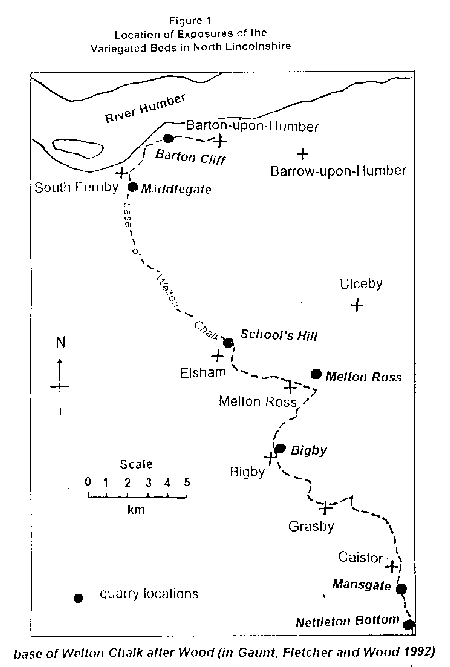
Lithological Descriptions
A common pattern of eight distinct lithological units has been recognised at all of the localities. The Melton Ross sequence however shows some deviation from the norm and is regarded as anomalous. A generalised 'normal' succession of the Variegated Beds is shown in Figure 2. This compares with a standard sequence of ten units recognised by Wood et al (ibid).
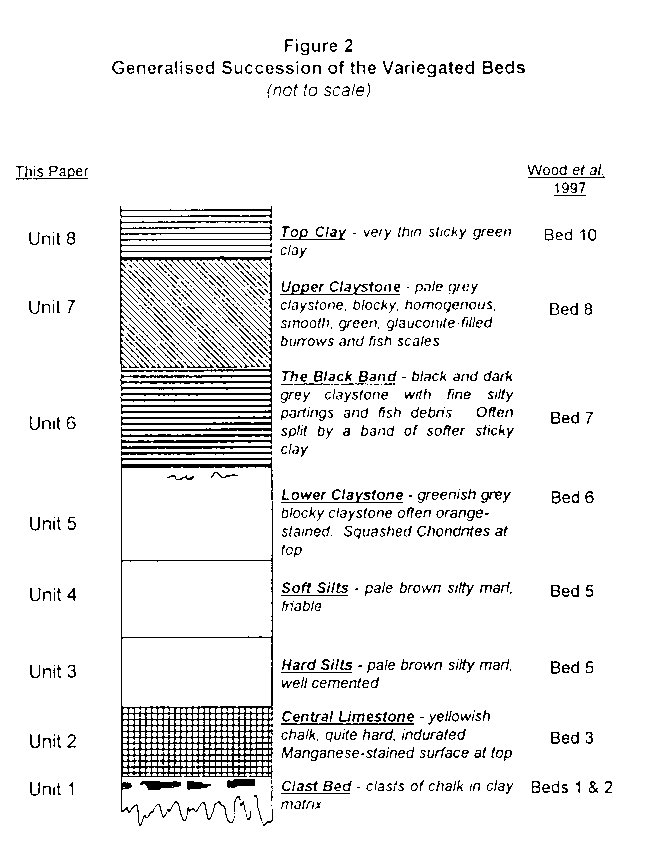
The lowest unit (Unit 1) is complex, about 2 to 4cm thick, in which clasts of hard chalk are contained in a matrix of, usually, greenish grey clay. This is the conglomeratic bed of Jefferies (1963). The lowest parts of the clay matrix occupy pipes or burrows into the underlying, often yellow- and greenish-stained, erosion surface of the Ferriby Chalk and may be distinct from the remainder of the clay in the unit (Wood 1997 personal communication). Orbirhynchia multicostata Pettitt has been retrieved from the clay at Mansgate and Nettleton Bottom, whilst Orbirhynchia sp. and a well-cemented valve of Atreta sp. or Crania sp. has been found in a limestone clast at Bigby. lnoceramid fragments were recovered from clasts of yellow-stained limestone with stylolites at Eisham. Unit 1 correlates with Beds 1 and 2 of Wood et al. (ibid).
A compact, chalky limestone bed, the Central Limestone (Unit 2), (= Bed 3 of Wood et al.), rests on the Clast Bed with slightly curved lower surfaces which at Schooi's Hill Quarry, Eisham resemble flute casts. The limestone of this unit tends to be less indurated than that forming the clasts of Unit 1. In each locality the top surface of the Central Limestone is characterised by a distinctive, black (manganese dioxide)-coated bedding plane. A well-preserved specimen of Orbirhynchia multicostata Pettitt was collected from this surface at Bigby.
Siltstones, containing varying amounts of calcium carbonate, comprise Units 3 and 4. The lower of the two, the Hard Silts unit, consists of 5 to 10cm of pale, brownish, compacted and well-cemented siltstone and silty marl containing common Omatothyris cf. latissima. More clayey siltstone is often evident at the base. Wood et al. (ibid) recognise this as a separate unit which they attribute to their Bed 4. There is a distinct boundary between Units 3 and 4. There is little change in colour or in grain size but there is a significant difference in the degree of cementation. A 'ledge' is quickly produced along the bedding plane marking the top of the Hard Silts unit when weathered sections are excavated and scraped clear of debris.
The Soft Silts (Unit 4) is a friable siltstone generally some 2 to 8cm thick but at Nettleton Bottom Quarry there is an unusually thick development of 20cm. In most localities the Soft Silts have a sharply defined top but this becomes less clear and much more gradational towards the northern end of the area. Macrofossils are not as common in this unit as in the underlying Hard Silts. A well-worn Orbirhynchia sp. and delicately preserved, thin-shelled brachiopod fragments have been recovered including Monticlarella jeffetiesi Owen together with flattened burrows of ?Thalassinoides sp. Wood et al. (ibid) place both silt units together as their Bed 5.
The succeeding Lower Claystone (Unit 5), (= Bed 6 of Wood et al.), consists of up to 15cm of homogenous, greenish grey claystone. This is commonly orange stained and blocky with occasional rotted pyrite nodules and burrows. M. jefferiesi Owen and a small (?juvenile) oyster were collected from Barton Cliff. Pyrite casts occur in abundance, some suggesting helicoidal burrow structures, together with grey inclusions which appear to consist of bioturbated sediment with comminuted fish debris. The top few centimetres contain squashed Chondrites and begin to include darker laminations which herald the distinctive dark grey to black claystone and silty claystone of the Black Band.
The Black Band (Unit 6) (= Bed 7 of Wood et al.) is remarkably uniform in thickness across the study area usually between 10 and 12 cm. It consists of dark brown to black carbonaceous mar] with paler silty laminations along which the beds split readily. These partings often reveal phosphatic fish debris including scales and small teeth. A purplish tinge is apparent in the Black Band unit at Mansgate and Nettleton Bottom Quarries and there is a hint of this at Bigby. Wood (in Gaunt, Fletcher and Wood 1992) describes the Black Band of the Louth area as being dark purple in colour. The southern end of the study area is clearly the northern extent of this colouration. The Nettleton Bottom exposure displays a thin (7cm) development. In each locality the Black Band is divided by a thin layer of soft sticky, more brownish, clay which is highly bioturbated and associated with common fish debris. This horizon is probably the fish layer recorded by Wood and Mortimore (1 995).
The dark colouration of the Black Band continues as wisps and laminations in the Upper Claystone (Unit 7) (= Bed 8 of Wood et al.). This unit consists of 7 to 13cm of smooth, greenish grey, homogenous claystone not unlike the lithology of the Lower Claystone. Fish debris is occasionally found along bedding planes and there are often traces of burrows, some with 'frilly' margins, which are possibly glauconite-filled.
The top of the Variegated Beds is marked by a thin (1 to 2cm) unit of soft, sticky, green clay (Unit 8) (= Bed 10 of Wood et al). Although very thin, Wood et al. (ibid) claim that it can be recognised in all sections throughout Lincolnshire. The variation in thickness of the Variegated Beds and its individual units, together with a correlation between sites, is shown in Figure 3.
Fig 3
The Melton Ross Anomaly
Fig 4
Comparason and tent correlation of the Melton Ross and Bigby (Standard)
Sequences
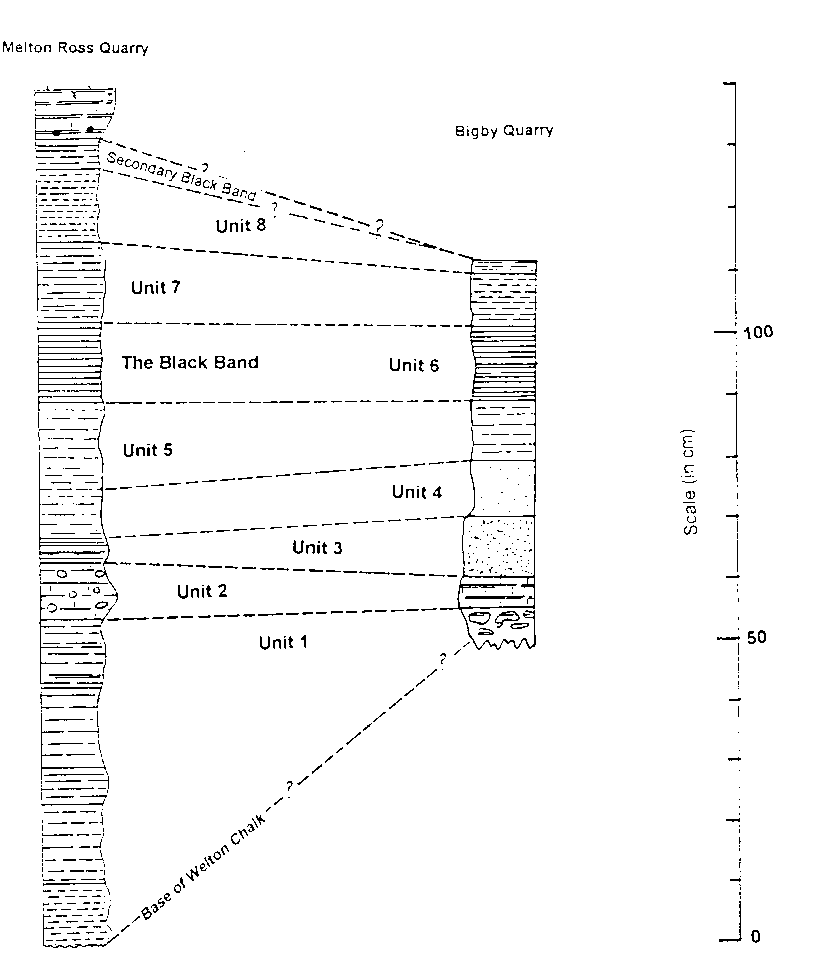
An excavation by Singleton-Birch Ltd. in the floor of the working quarry in late Autumn 1994 exposed an anomalous section of the Variegated Beds (Wood and Mortimore 1995). The author visited the site (TA 08051138) in Summer 1997 and recorded the succession shown in Figure 4 where it is also compared with a (normal sequence. The most obvious difference from other sites is the increase in total thickness from about 0.5 metres to 1.3 metres. Wood and Mortimore (1995) have interpreted this anomaly as evidence for a basin and swell sedimentary topography in the Chalk of the Lincolnshire Wolds. A reflection of this topography may possibly also be apparent in a thickening of the lower part of the succeeding Weiton Chalk beds. Whitham (1991) observed a thickening of the Sciponoceras gracile zone from Melton Bottoms (East Yorkshire) towards Eisham and the author has recorded some thickening of the interval between the First Flints Unit and the First Main Flint (1.8m at Barton Cliff and Grasby; 2.1 m at Elsham; 2.4m at Melton Ross). Some conformity with the 'normal' succession is apparent in Units 2 to 7. The Clast Bed is not present at Melton Ross, its position is occupied by 50 cm of greyish green, occasionally orange brown, very finely laminated claystones with gradational boundaries. Chalk nodules and laminations occur in the claystone directly beneath a bed of brownish white, nodular limestone which is correlated with Unit 2, the Central Limestone. Delicately preserved M. jeffeilesi Owen were collected from a silty bed (Unit 4) which has a sharp boundary with overlying greenish grey, vaguely laminated claystone (Unit 5).
The Black Band, as elsewhere in the area, is very dark grey to black with paler laminations and lenses. Unit 8, the Top Clay of the 'normal' succession, may be expanded and represented by 12cm of soft, brownish green, slightly silty clay. The top of the Melton Ross exposure shows 5cm of chocolate brown claystone with dark grey laminations. This resembles a thinner version of the Black Band (Unit 6) and is referred to as a 'secondary' Black Band. Wood (in Kent 1980) describes the 'variegated succession' of Speeton as containing more than one black band, likening it to correlative sequences in the Lower Saxony and Munster basins of West Germany.
Lateral Variations
Fig 5
Variations in thickness of the Varigated Beds in North Linconshire
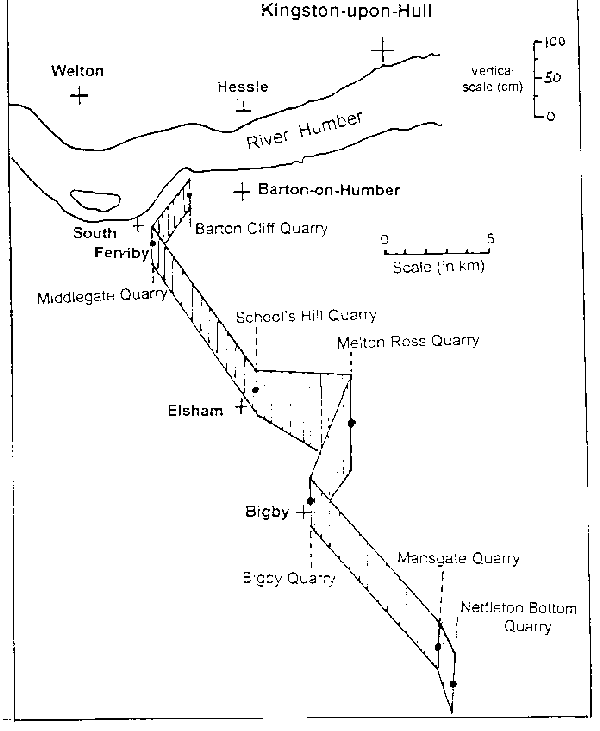
Variations in the total thickness of the Variegated Beds and between
thicknesses of individual units have been analysed statistically. Data
from the Melton Ross section, because of its undisputed anomalous nature,
has been omitted. Table 1 illustrates the recorded thicknesses of each
unit from the other six locations together with a calculation of Standard
Deviation using the formula:
Table 1
Thickness of individual units (cm.) of the Varigated Beds with Mean Thickness and Standard Deviation
|
|
|
|
|
|
|
|
|
|
| Top Clay |
|
|
|
|
|
|
|
|
| U. Claystone |
|
|
|
|
|
|
|
|
| Black Band |
|
|
|
|
|
|
|
|
| L. Claystone |
|
|
|
|
|
|
|
|
| Soft Silts |
|
|
|
|
|
|
|
|
| Hard Silts |
|
|
|
|
|
|
|
|
| C. Lstne |
|
|
|
|
|
|
|
|
| Clast Bed |
|
|
|
|
|
|
|
|
| Total |
|
|
|
|
|
|
|
|
The total thickness of the Variegated Beds is very variable but shows a general increase towards the south. Figure 5 illustrates both this general southward thickening and the Melton Ross anomaly. Standard Deviation results for individual units (Table 1) show little deviation from the mean in most cases. The exceptions are Unit 3 (Hard Silts), which displays some deviation ( 8 = 2.28) and Units 4 and 5 (Soft Silts and Lower Claystone) where there is significant deviation.
Table 2 shows the thickness of each unit expressed as a percentage of
the mean- These figures again demonstrate the southward thickening of the
full sequence and that the variation of individual units may follow a pattern.
Unit 1 (Clast Bed) appears to thicken northwards in contrast to the following
four units (Units 2, 3, 4 and 5) which all thicken southwards. Above these,
Units 6, 7 and 8 show little evidence of a recognisable pattern. Plots
of the thickness of individual units against total thickness of the Variegated
Beds at each location, other than Melton Ross, are presented in Figures
6 to 9. Results from Figure 6 suggest a strong negative relationship, that
the thickness of the Clast Bed (Unit 1) decreases as the total thickness
of the sequence increases. This is in contrast to the strong positive relationships
noticeable in Figures 7 to 9 where Units 2, 3 and 4 all appear to thicken
proportionately to the increase in thickness of the total Variegated Beds.
Calculations using the Spearman Rank Correlation Coefficient formula:
to examine the relationship between the total thickness of the Variegated Beds and certain individual units reveal a 95% significance (Rs=+0.83) in that of the Central Limestone (Unit 2) and a 97% significance (Rs=+0.91) in that of the Soft Silts (Unit 4).
Table 2
Thickness of individual units of the Varigated beds expressed as a percentage of the mean thickness
|
|
|
|
|
|
|
|
| Top Clay |
|
|
|
|
|
|
| U. Claystone |
|
|
|
|
|
|
| Black Band |
|
|
|
|
|
|
| L. Claystone |
|
|
|
|
|
|
| Soft Silts |
|
|
|
|
|
|
| Hard Silts |
|
|
|
|
|
|
| C. Lstne |
|
|
|
|
|
|
| Clast Bed |
|
|
|
|
|
|
| Total |
|
|
|
|
|
|
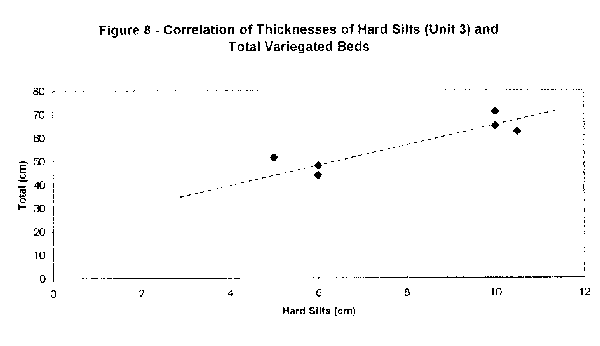
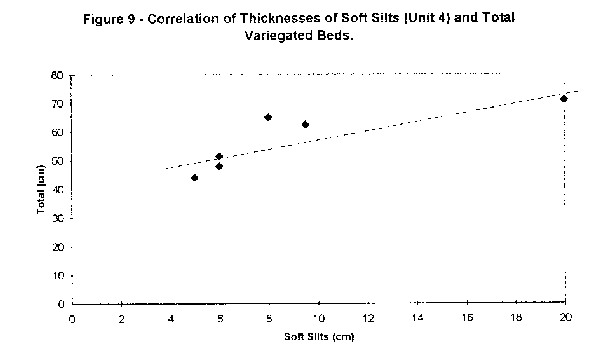
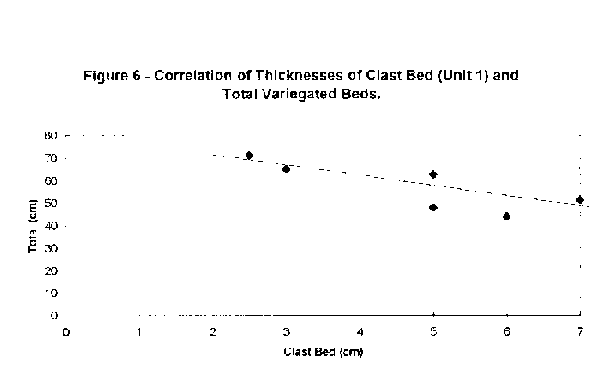
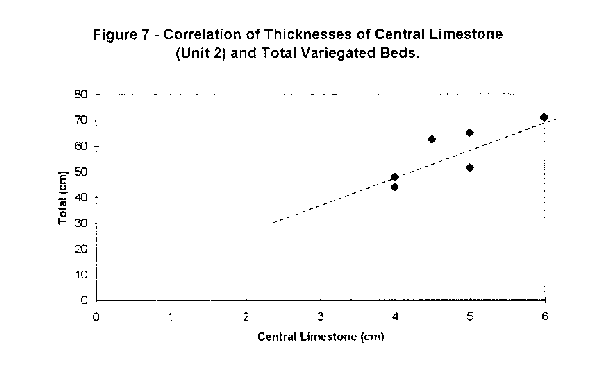
Although there is much variance in the thickness of the Variegated Beds sequence in North Lincolnshire and in individual lithological units, even in exposures within the same quarry, evidence appears to be available for the recognition of certain patterns. There is undoubtedly a gradual general thickening of the sequence from north to south with a noticeable swell in the Melton Ross area, probably a response to local contemporaneous sedimentary conditions. Statistical information based on the sections displaying the 'normal' sequence would seem to support a relationship between certain beds and the total thickness of the sequence. That these relationships are not common to all beds may be due to the severe compression of the relatively soft, very thin units by the overlying chalk. This quite severe compaction is evidenced by deformed macrofossils, especially Orbirhynchia spp.
The Variegated Beds rest upon an erosion surface and also contain at least one other. These periods of non-deposition and removal of sediment together with the likely diachronous nature of the beds would contribute towards their varied nature. There is little doubt that the Melton Ross section together with the variation described from standard sections indicate a complex group of beds which still require further research. Microfossil studies may provide greater clarification but the collection of specimens, particularly from the lowest units, will require meticulous sampling techniques.
It is hoped that some agreement can be reached by authors over nomenclature. Whether or not member status for the Variegated Beds is justified is debatable. Naming the sequence after a locality is difficult. 'Standard' sections vary from one locality to another, there is no guarantee that clear sections will remain available and, as shown in recent publications, the standard sections are condensed.
Acknowledgements
I am indebted to the unquenchable enthusiasm of Mr. C.L. Wood for refuelling my interest in the Chalk and making me determined to work on the sections still available in North Lincolnshire before they, like many in recent years, disappear forever. His guidance in the field, help with macrofossil identification and informative telephone conversations have all been invaluable.
Encouragement from members of the Hull Geological Society, particularly Mike Horne and Felix Whitham, prompted publication of my researches. Mike has read the manuscripts and made constructive comments throughout their development.
References
GAUNT, FLETCHER, and WOOD, C.J. 1992. Geology of the country around Kingston upon Hull and Brigg. HMSO for Geol. Surv. Of Gt Britain. 71 -1 01.
HORNE, M. 1995. The Black Band Sequence. Humberside Geologist 11, 4041.
JEFFERIES, R.P.S. 1963. The stratigraphy of the Actinocamax plenus Subzone (Turonian) in the Anglo-Paris Basin. Proc. Geol. Assoc. 74, 1-33.
MITCHELL, S. 1995. The Black Band at Speeton. Humberside Geologist. 11, 42-43.
NEALE, J.W. 1974. Cretaceous in RAYNER D.H. and HEMINGWAY J.E. (Editors), The Geology and Mineral Resources of Yorkshire. Yorkshire Geological Society.
ROWE, A.W. 1904. The Zones of the White Chalk of the English Coast. 4 Yorkshire. Proc. Geol Assoc. 20, 193-296.
WHITHAM, F. 1991. The Stratigraphy of the Upper Cretaceous Ferriby, Welton and Burnham formations north of the Humber, north east England. Proc. Yorkshire Geol. Soc. 48, 227-254.
WILSON, V. 1948. The Cretaceous System. British Regional Geology (East Yorkshire and Lincolnshire). HMSO.
WOOD, C.J. and SMITH, E.G. 1978. Lithostratigraphical classification of the Chalk in North Yorkshire, Humberside and Lincolnshire. Proc. Yorkshire. Geol. Soc. 42, 263-287.
WOOD, C.J. 1980. The Upper Cretaceous in KENT, P.E. British Regional Geology (Eastem England from the Tees to The Wash). HMSO.
WOOD, C.J. and MORTIMORE, R.N. 1995. An anomalous Black Band succession (Cenomanian-Turonian boundary interval) at Melton Ross,
Lincolnshire, eastern England and its international significance. Berliner geowiss. Abh. 277-287.
WOOD, C.J., BATTEN, D.J., MORTIMORE, R.N. and WRAY, D.S. 1997. The stratigraphy and correlation of the Cenomanian-Turonian boundary interval succession in Lincolnshire, eastern England. FreibergerForschungsheft. C468; S333-346.
Copyright Hull Geological Society 1999
Copyright - Hull Geological Society 2020
Registered Educational Charity No. 229147